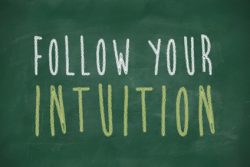How Do You Interpret the World? Perspectives on Intuition
August 30, 2018 ~ Written by: W.B. “Bud” Kirchner
Approx. Read Time: 6.5 Minutes
“The only real valuable thing is intuition.” – Albert Einstein
The Role of Intuition
A big focus of the Business Brain Model articles has been decision-making, including the role of intuition. Examples include Business vs. Science: Are you losing this fight? and Creating Innovation: A Recipe for Innovation Stew.
The purpose of this article is to share some additional perspectives on intuition themes that are fundamental components of individual thinking – and in particular, describe some of their limitations.
Simply put, your intuition is your initial impressions of the world around you – before you ‘learn’ specific principles. They reflect both expectations (belief) and experience (perception).
My approach for this article will be to extract some of the more salient points from the following sources and then supplement those with complimentary points from a few related articles. I will then bring it all together with a couple of examples.
Primary in terms of my resources is the recent book by Andrew Shtulman (Scienceblind: Why Our Intuitive Theories About the World Are So Often Wrong). While the book focuses on twelve intuitive theories, they are not the only such theories we humans hold.
Fundamental ideas as quoted from the author:
- “We do, in fact, get the world wrong – that our intuitive theories in several domains of knowledge carve up the world into entities and processes that do not actually exist.”
- “To get the world right, we need to do more than just change our beliefs; we need to change the very concepts that articulate those beliefs.”
- “There are many, many truths that are not easy to understand because they defy our earliest developing and most easily accessed ideas about how the world works.”
- “Intuitive theories may help us answer the small questions in life (e.g., what should I eat, where should I step, how can I get well?), but only scientific theories help us answer the big ones (e.g., who are we, where did we come from, where we are going?).”
Shtulman goes on to state that because children lack the concepts essential to encode scientific information, intuitive theories (they deal with objects not concepts) are here to stay. They are a “permanent fixture of human cognition”.
Bruce Hood, Professor of Developmental Psychology in Society, University of Bristol and author of The Self Illusion sums up this work as follows:
- “Shtulman explains why we are all vulnerable to intuitive misconceptions, the potential harm intuitions can wreak.”
Additional Perspective
“Intuition becomes increasingly valuable in the new information society precisely because there is so much data.” – John Naisbitt
Several other authors have addressed this topic; I quote their more salient points:
- The Powers and Perils of Intuition by David G. Myers
- “Intuition—an effortless, immediate, unreasoned sense of truth—sometimes errs”
- “Intuitions shape our anxieties, impressions and relationships.”
- “We know more than we know we know.”
- “Scientists who expose intuition’s flaws note that it works well in some areas, but needs restraints and check.”
- To Become Truly Pro-Science, Forget Everything You Believe by Sarah Sloat
- “Understanding science, he argues, is more than just agreeing with a protest sign; it’s a lifelong process of continually evaluating our beliefs so we can catch ourselves when we default to our intuitive theories about the world, which are often wrong.”
- Why Scientific Thinking Matters for Society by Joshua B. Grace
- “Our untutored explanations for how the world works” continue to shape our thinking.”
- “Like a palimpsest, our minds record new theories (scientific theories) on top of old theories (intuitive theories) such that both theories can become active at the same time, providing competing explanations or competing predictions. . .. In some cases, our scientific knowledge may be nothing more than a veneer, thinly covering misconceptions forged decades earlier, when we were children.”
- “Our understanding of natural phenomena has widespread social implications as well. Vaccination, pasteurization, stem cell research, cloning, fertility treatment, genetic modification of food, genetic modification of microbes, antibiotics, pesticides, cryogenics, space exploration, nuclear power, climate change: these science-laden issues affect society as a whole. It is important not just that scientists understand them but that everyone understands them.”
As always, I raise the bar for the more serious readers and direct you to the two articles for the scientific literature that seems particularly relevant:
- Intuitive Theories
- Tuition vs. Intuition: Effects of Instruction on Naïve Theories of Evolution
Illustrations
Rather than give the impression this is some sort of philosophical discussion, I now offer up a couple of examples, starting with the ridiculous and moving to the sublime.
Back to Shtulman, who reminds readers of an old riddle: “which is heavier, a pound of feathers or a pound of gold? You know it’s a trick. But you probably felt a little inner tug toward answering “gold”. That feeling is your intuitive theory about heft and bulk – learned as a baby, or maybe hardwired – interfering with your intellectual understanding of weight” (common sense isn’t always that sensible).
A more poignant illustration:
Another good example of how misleading your intuition can be appearing in Thaler’s book Misbehaving: The Making of Behavioral Economics.
(Of course, Thaler and his work was the subject of an earlier Business Brain Article.)
Given how this relies so heavily on Pythagorean math – the description and diagram are also found in many additional sources (University of Georgia’s Expanding Bridge – Braingle’s Rising Train Tracks Brain Teaser).
The following is a direct excerpt from Thaler’s book:
Consider two pieces of railroad track, each a mile long, laid end to end (see figure 1). The tracks are secured at their end points but simply meet in the middle. In extreme heat, the railroad tracks expand, each by one inch. Since they are attached to the ground at the end points, the tracks can only expand by rising like a drawbridge. Furthermore, these pieces of track are so sturdy that they retain their straight, linear shape as they go up which makes the math much simpler.
By way of perspective – looking at one side we identify a right triangle with a base of one mile and based on the expansion a hypotenuse of one mile plus one inch. What is the altitude? That is to say – how far above the ground is the juncture?
(Diagram reproduced from Misbehaving: The Making of Behavioral Economics and other sources cited)
Figure 1
Again – the math is straightforward Pythagorean geometry involving square root functions.
If rather than do the math you make an intuitive guess – what would it be?
Most people “intuitively” figure that since the tracks expanded by an inch they should go up roughly the same amount.
The actual answer is 29.7 feet!
How do you feel about your intuition at this point?
Conclusion
In closing, I would like to propose as I often do – that there is no ‘right/wrong’ answer here. In other words, good (business) decisions involve elements (to varying degrees) of science and intuition.
“It is through science that we prove, but through intuition that we discover.” – Henri Poincare
Bibliography
- Braingle – Rising Train Tracks
- Oliver Burkeman – Common sense isn’t always that sensible
- Joshua B. Grace – Why scientific thinking matters for society
- David G. Myers – The Powers and Perils of Intuition
- Martin Robson and Peter Miller – Australian elite leaders and intuition
- Andrew Shtulman – Scienceblind: Why Our Intuitive Theories About the World Are So Often Wrong
- Sarah Sloat – To Become Truly Pro-Science, Forget Everything You Believe
- Richard H. Thaler – Misbehaving: The Making of Behavioral Economics
- University of Georgia – Jim Wilson – Expanding Bridge
Other sources:
- Tobias Gerstenberg and Joshua B. Tenenbaum – Intuitive Theories
- Andrew Shtulman and Prassede Calabi – Tuition vs. Intuition: Effects of Instruction on Naive Theories of Evolution
Relevant Business Brain Model articles:
- Thaler Explained Why It Makes Sense That Things Don’t Make Sense
- Business vs. Science: Are you losing this fight?
About the Author: W.B. “Bud” Kirchner is a serial entrepreneur and philanthropist with more than 50 years of business success. He is not a scientist or an academic but he does have a diversified exposure to neuroscience, psychology and related cognitive sciences. Generally speaking, the ideas he expresses here are business-angled expansions of other people’s ideas, so when possible, he will link to the original reference.



